 Technology peripherals
Technology peripherals
 AI
AI
 MotionLM: Language modeling technology for multi-agent motion prediction
MotionLM: Language modeling technology for multi-agent motion prediction
MotionLM: Language modeling technology for multi-agent motion prediction
This article is reprinted with the authorization of the Autonomous Driving Heart public account. Please contact the source for reprinting.
Original title: MotionLM: Multi-Agent Motion Forecasting as Language Modeling
Paper link: https://arxiv.org/pdf/2309.16534.pdf
Author affiliation: Waymo
Conference: ICCV 2023

Paper idea:
For autonomous vehicle safety planning, Reliably predicting future behavior of road agents is critical. This study represents continuous trajectories as sequences of discrete motion tokens and treats multi-agent motion prediction as a language modeling task. Our proposed model, MotionLM, has several advantages: First, it does not require the use of anchor points or explicit latent variables to optimally learn multi-modal distributions. Instead, we exploit the standard language modeling objective of maximizing the average log probability of sequence tokens. Second, our approach avoids post hoc interaction heuristics, where individual agent trajectory generation occurs after interaction scoring. In contrast, MotionLM generates a joint distribution of interactive agent futures in a single autoregressive decoding process. In addition, the sequential decomposition of the model enables temporal causal condition inference. Our proposed method achieves new state-of-the-art performance on the Waymo Open Motion Dataset, ranking first on the interactive challenge leaderboard
Main Contributions:
Here In this article, we discuss multi-agent motion prediction as a language modeling task. We introduce a temporal causal decoder to decode discrete motion tokens trained with a causal language modeling loss
This paper will combine sampling in the model with a simple rollout aggregation scheme to improve the weighted pattern of the joint trajectory Recognition ability. Through experiments in the Waymo Open Motion Dataset interaction prediction challenge, we have demonstrated that this new method improves the ranking joint mAP metric by 6% and reaches the state-of-the-art performance level
This article's approach to this article Extensive ablation experiments are performed and its temporal causal conditional predictions are analyzed, which are largely unsupported by current joint prediction models.
Network Design:
The goal of this paper is to model the distribution on multi-agent interactions in a general way that can be applied to different Downstream tasks, including minimal, joint, and conditional predictions. To achieve this goal, an expressive generative framework is needed that can capture the multiple morphologies in driving scenes. Furthermore, we consider saving time dependencies here; that is, in our model, the inference follows a directed acyclic graph, with each node’s parent node being earlier in time and its child node being later in time, which makes Conditional prediction is closer to causal intervention because it eliminates certain spurious correlations that would otherwise lead to disobedience to temporal causality. This paper observes that joint models that do not preserve temporal dependencies may have limited ability to predict actual agent responses, a key use in planning. To this end, this paper utilizes an autoregressive decomposition of the future decoder, where the agent’s motion tokens conditionally depend on all previously sampled tokens and the trajectories are sequentially derived
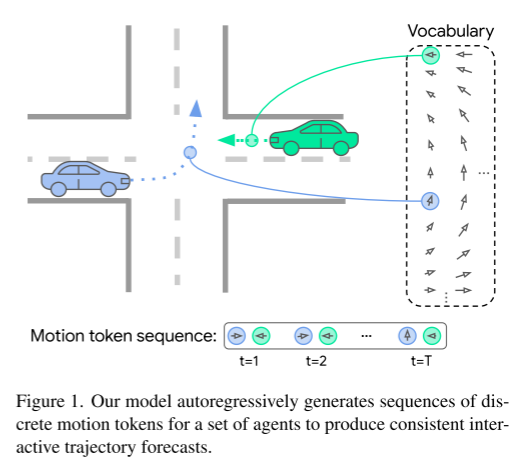
figure 1. Our model autoregressively generates sequences of discrete motion tokens for a set of agents to produce consistent interactive trajectory predictions.
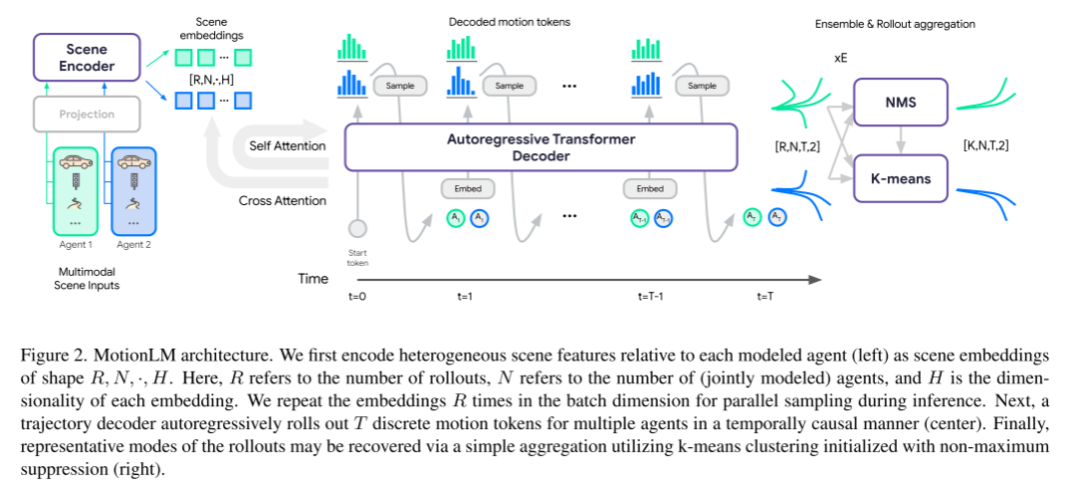
Please look at Figure 2, which is the architecture of MotionLM
This article first encodes the heterogeneous scene features (left) related to each modeling agent for scene embeddings of shape R,N,·,H. Among them, R is the number of rollouts, N is the number of jointly modeled agents, and H is the dimensionality of each embedding. During the inference process, in order to parallelize sampling, this paper repeats the embedding R times in the batch dimension. Next, a trajectory decoder rolls out T discrete motion tokens for multiple agents in a temporally causal manner (center). Finally, the typical pattern of rollouts can be recovered by simple aggregation of k-means clusters using non-maximum suppression initialization (right panel).

image 3. The first two prediction joint rollout modes for three WOMD scenarios are shown.
The color gradient represents the time change from t = 0 seconds to t = 8 seconds. The joint mode transitions from green to blue, and the sub-joint mode transitions from orange to purple with the highest probability. We observed three types of interactions: agents in adjacent lanes will give way to the lane-changing agent according to the lane-changing time (left), pedestrians will walk behind passing vehicles according to the vehicle's progress (center), and turning vehicles will either Will give way to a passing cyclist (most likely mode) or will turn before a cyclist approaches (minor mode) (right side)

Please see Figure 4. This figure shows the causal Bayesian network representation of joint induction (left), post-intervention causal Bayesian network (middle), and causal conditioning (right)
Solid lines represent causality in time Correlation, while the dashed lines represent causal information flow. A model without time-dependent constraints will support causal conditioning but not temporal causal conditioning, which can be problematic when trying to predict agent responses.
Experimental results:
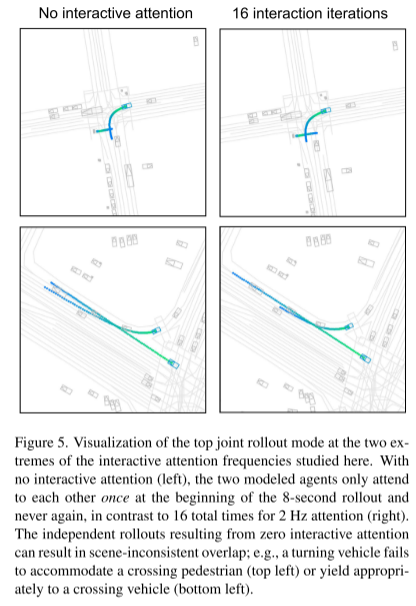
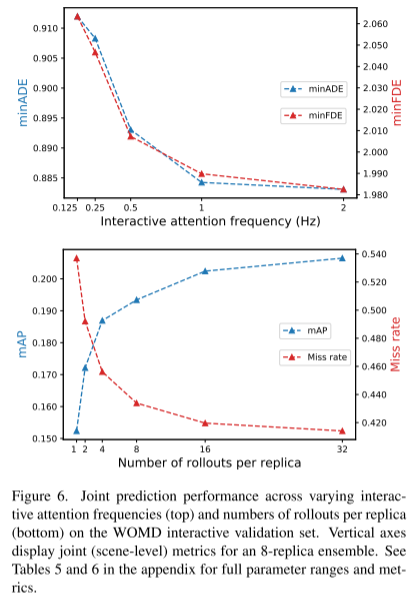
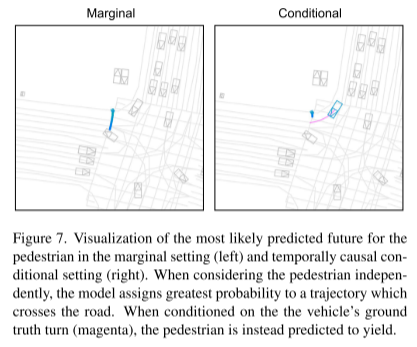


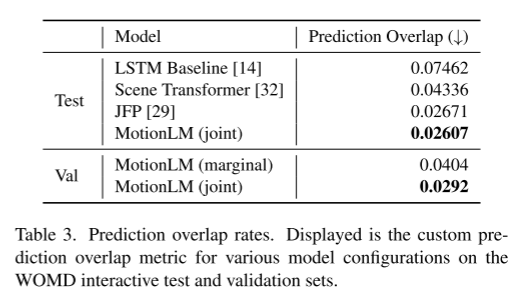

# Quote:
Seff, A., Cera, B., Chen, D., Ng, M., Zhou, A., Nayakanti, N., Refaat, K. S., & Sapp, B. (2023). MotionLM: Multi-Agent Motion Forecasting as Language Modeling.ArXiv. /abs/2309.16534

The above is the detailed content of MotionLM: Language modeling technology for multi-agent motion prediction. For more information, please follow other related articles on the PHP Chinese website!

Hot AI Tools

Undresser.AI Undress
AI-powered app for creating realistic nude photos

AI Clothes Remover
Online AI tool for removing clothes from photos.

Undress AI Tool
Undress images for free

Clothoff.io
AI clothes remover

Video Face Swap
Swap faces in any video effortlessly with our completely free AI face swap tool!

Hot Article

Hot Tools

Notepad++7.3.1
Easy-to-use and free code editor

SublimeText3 Chinese version
Chinese version, very easy to use

Zend Studio 13.0.1
Powerful PHP integrated development environment

Dreamweaver CS6
Visual web development tools

SublimeText3 Mac version
God-level code editing software (SublimeText3)

Hot Topics
 1393
1393
 52
52
 1207
1207
 24
24
 The world's most powerful open source MoE model is here, with Chinese capabilities comparable to GPT-4, and the price is only nearly one percent of GPT-4-Turbo
May 07, 2024 pm 04:13 PM
The world's most powerful open source MoE model is here, with Chinese capabilities comparable to GPT-4, and the price is only nearly one percent of GPT-4-Turbo
May 07, 2024 pm 04:13 PM
Imagine an artificial intelligence model that not only has the ability to surpass traditional computing, but also achieves more efficient performance at a lower cost. This is not science fiction, DeepSeek-V2[1], the world’s most powerful open source MoE model is here. DeepSeek-V2 is a powerful mixture of experts (MoE) language model with the characteristics of economical training and efficient inference. It consists of 236B parameters, 21B of which are used to activate each marker. Compared with DeepSeek67B, DeepSeek-V2 has stronger performance, while saving 42.5% of training costs, reducing KV cache by 93.3%, and increasing the maximum generation throughput to 5.76 times. DeepSeek is a company exploring general artificial intelligence
 AI subverts mathematical research! Fields Medal winner and Chinese-American mathematician led 11 top-ranked papers | Liked by Terence Tao
Apr 09, 2024 am 11:52 AM
AI subverts mathematical research! Fields Medal winner and Chinese-American mathematician led 11 top-ranked papers | Liked by Terence Tao
Apr 09, 2024 am 11:52 AM
AI is indeed changing mathematics. Recently, Tao Zhexuan, who has been paying close attention to this issue, forwarded the latest issue of "Bulletin of the American Mathematical Society" (Bulletin of the American Mathematical Society). Focusing on the topic "Will machines change mathematics?", many mathematicians expressed their opinions. The whole process was full of sparks, hardcore and exciting. The author has a strong lineup, including Fields Medal winner Akshay Venkatesh, Chinese mathematician Zheng Lejun, NYU computer scientist Ernest Davis and many other well-known scholars in the industry. The world of AI has changed dramatically. You know, many of these articles were submitted a year ago.
 Google is ecstatic: JAX performance surpasses Pytorch and TensorFlow! It may become the fastest choice for GPU inference training
Apr 01, 2024 pm 07:46 PM
Google is ecstatic: JAX performance surpasses Pytorch and TensorFlow! It may become the fastest choice for GPU inference training
Apr 01, 2024 pm 07:46 PM
The performance of JAX, promoted by Google, has surpassed that of Pytorch and TensorFlow in recent benchmark tests, ranking first in 7 indicators. And the test was not done on the TPU with the best JAX performance. Although among developers, Pytorch is still more popular than Tensorflow. But in the future, perhaps more large models will be trained and run based on the JAX platform. Models Recently, the Keras team benchmarked three backends (TensorFlow, JAX, PyTorch) with the native PyTorch implementation and Keras2 with TensorFlow. First, they select a set of mainstream
 Hello, electric Atlas! Boston Dynamics robot comes back to life, 180-degree weird moves scare Musk
Apr 18, 2024 pm 07:58 PM
Hello, electric Atlas! Boston Dynamics robot comes back to life, 180-degree weird moves scare Musk
Apr 18, 2024 pm 07:58 PM
Boston Dynamics Atlas officially enters the era of electric robots! Yesterday, the hydraulic Atlas just "tearfully" withdrew from the stage of history. Today, Boston Dynamics announced that the electric Atlas is on the job. It seems that in the field of commercial humanoid robots, Boston Dynamics is determined to compete with Tesla. After the new video was released, it had already been viewed by more than one million people in just ten hours. The old people leave and new roles appear. This is a historical necessity. There is no doubt that this year is the explosive year of humanoid robots. Netizens commented: The advancement of robots has made this year's opening ceremony look like a human, and the degree of freedom is far greater than that of humans. But is this really not a horror movie? At the beginning of the video, Atlas is lying calmly on the ground, seemingly on his back. What follows is jaw-dropping
 KAN, which replaces MLP, has been extended to convolution by open source projects
Jun 01, 2024 pm 10:03 PM
KAN, which replaces MLP, has been extended to convolution by open source projects
Jun 01, 2024 pm 10:03 PM
Earlier this month, researchers from MIT and other institutions proposed a very promising alternative to MLP - KAN. KAN outperforms MLP in terms of accuracy and interpretability. And it can outperform MLP running with a larger number of parameters with a very small number of parameters. For example, the authors stated that they used KAN to reproduce DeepMind's results with a smaller network and a higher degree of automation. Specifically, DeepMind's MLP has about 300,000 parameters, while KAN only has about 200 parameters. KAN has a strong mathematical foundation like MLP. MLP is based on the universal approximation theorem, while KAN is based on the Kolmogorov-Arnold representation theorem. As shown in the figure below, KAN has
 FisheyeDetNet: the first target detection algorithm based on fisheye camera
Apr 26, 2024 am 11:37 AM
FisheyeDetNet: the first target detection algorithm based on fisheye camera
Apr 26, 2024 am 11:37 AM
Target detection is a relatively mature problem in autonomous driving systems, among which pedestrian detection is one of the earliest algorithms to be deployed. Very comprehensive research has been carried out in most papers. However, distance perception using fisheye cameras for surround view is relatively less studied. Due to large radial distortion, standard bounding box representation is difficult to implement in fisheye cameras. To alleviate the above description, we explore extended bounding box, ellipse, and general polygon designs into polar/angular representations and define an instance segmentation mIOU metric to analyze these representations. The proposed model fisheyeDetNet with polygonal shape outperforms other models and simultaneously achieves 49.5% mAP on the Valeo fisheye camera dataset for autonomous driving
 Tesla robots work in factories, Musk: The degree of freedom of hands will reach 22 this year!
May 06, 2024 pm 04:13 PM
Tesla robots work in factories, Musk: The degree of freedom of hands will reach 22 this year!
May 06, 2024 pm 04:13 PM
The latest video of Tesla's robot Optimus is released, and it can already work in the factory. At normal speed, it sorts batteries (Tesla's 4680 batteries) like this: The official also released what it looks like at 20x speed - on a small "workstation", picking and picking and picking: This time it is released One of the highlights of the video is that Optimus completes this work in the factory, completely autonomously, without human intervention throughout the process. And from the perspective of Optimus, it can also pick up and place the crooked battery, focusing on automatic error correction: Regarding Optimus's hand, NVIDIA scientist Jim Fan gave a high evaluation: Optimus's hand is the world's five-fingered robot. One of the most dexterous. Its hands are not only tactile
 The latest from Oxford University! Mickey: 2D image matching in 3D SOTA! (CVPR\'24)
Apr 23, 2024 pm 01:20 PM
The latest from Oxford University! Mickey: 2D image matching in 3D SOTA! (CVPR\'24)
Apr 23, 2024 pm 01:20 PM
Project link written in front: https://nianticlabs.github.io/mickey/ Given two pictures, the camera pose between them can be estimated by establishing the correspondence between the pictures. Typically, these correspondences are 2D to 2D, and our estimated poses are scale-indeterminate. Some applications, such as instant augmented reality anytime, anywhere, require pose estimation of scale metrics, so they rely on external depth estimators to recover scale. This paper proposes MicKey, a keypoint matching process capable of predicting metric correspondences in 3D camera space. By learning 3D coordinate matching across images, we are able to infer metric relative



